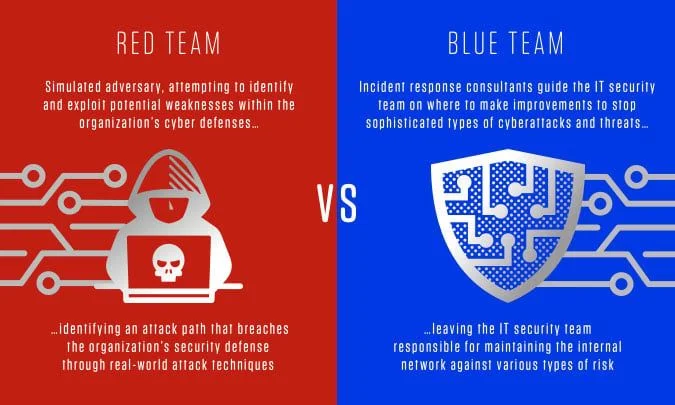
Red Team vs. Blue Team: Understanding Their Roles, Strategies, and How They Work Together in Cybersecurity
Introduction
In the world of cybersecurity, the Red Team and Blue Team represent two distinct roles with a common goal: strengthening an organization’s security. The Red Team simulates attacks to identify vulnerabilities, while the Blue Team defends against threats, focusing on detection, response, and mitigation. This article explores the differences between Red and Blue Teams, their techniques, and how they work together to enhance an organization’s cybersecurity posture.What is a Red Team?
The Red Team operates offensively, emulating real-world cyber attacks to test an organization’s defenses. By simulating tactics used by threat actors, the Red Team aims to expose vulnerabilities and highlight weaknesses in security infrastructure, employee awareness, and incident response capabilities.Primary Objectives of the Red Team:
- Discover security gaps and exploitable vulnerabilities.
- Test the organization’s response to simulated attacks.
- Provide actionable recommendations to strengthen defenses.
- Reconnaissance – Gathering information about the organization, including network infrastructure, employee details, and potential entry points.
- Social Engineering – Using techniques like phishing to gain initial access by exploiting human error.
- Exploitation and Lateral Movement – Exploiting weaknesses to escalate privileges and move through the network to reach sensitive assets.
- Data Exfiltration Simulation – Testing the ability to extract data undetected, replicating an attacker’s goal to access valuable information.
- Metasploit and Cobalt Strike for penetration testing and post-exploitation.
- BloodHound for mapping Active Directory environments and lateral movement.
- GoPhish for phishing simulations targeting employees.
- Impacket for network exploitation and credential manipulation.
What is a Blue Team?
The Blue Team, on the other hand, operates defensively, responsible for monitoring, detecting, and responding to threats. Blue Teams protect the organization’s assets by ensuring security policies are in place, vulnerabilities are minimized, and systems are monitored in real-time for suspicious activity.Primary Objectives of the Blue Team:
- Protect the organization’s network, data, and assets from threats.
- Detect and respond to threats in real time.
- Continuously improve defenses based on the latest threat intelligence.
- Continuous Monitoring and Threat Detection – Using SIEM and network monitoring tools to detect anomalies.
- Incident Response – Investigating alerts, containing threats, and eradicating malicious activity.
- Vulnerability and Patch Management – Identifying and addressing vulnerabilities to prevent potential exploits.
- Security Awareness Training – Educating employees on security best practices to reduce the risk of social engineering.
- Splunk and QRadar for log analysis and threat detection.
- CrowdStrike Falcon for endpoint detection and response (EDR).
- AlienVault OTX for threat intelligence and proactive defense.
- Snort for network intrusion detection and prevention.
Red Team vs. Blue Team: Key Differences
While both teams work toward a secure organization, their roles and methodologies differ significantly.| Aspect | Red Team | Blue Team |
|---|---|---|
| Role | Offensive (simulate attacks) | Defensive (detect and respond to threats) |
| Goal | Identify vulnerabilities and security gaps | Protect assets and maintain security |
| Approach | Real-world attack simulation | Continuous defense and incident response |
| Techniques | Social engineering, exploitation | Monitoring, incident response, training |
| Focus | Expose weaknesses and test response | Maintain proactive and reactive defenses |
| Tools | Cobalt Strike, BloodHound, Metasploit | SIEM, EDR, IDS/IPS |
How Red and Blue Teams Work Together: Purple Teaming
In many organizations, Red and Blue Teams collaborate through a process called Purple Teaming. This collaboration aims to strengthen security by combining the offensive insights of the Red Team with the defensive expertise of the Blue Team. Purple Teaming allows both teams to learn from each other, share insights, and create a feedback loop that improves overall security.Benefits of Purple Teaming:
- Improved Threat Detection – Red Team insights help the Blue Team recognize and respond to new attack patterns.
- Enhanced Defense Tactics – The Blue Team’s defenses can be tested and adjusted based on Red Team tactics, making them more resilient.
- Efficient Resource Allocation – By understanding specific vulnerabilities, organizations can prioritize resources for the most critical areas.
- Joint Exercises – Conducting attack and defense simulations where both teams collaborate to improve detection and response.
- Debriefing Sessions – Reviewing Red Team findings with the Blue Team to develop mitigation strategies.
- Continuous Feedback Loops – Using Red Team insights to refine Blue Team tools, policies, and detection methods.
Best Practices for Effective Red and Blue Team Operations
To maximize the impact of Red and Blue Teams, organizations should consider the following best practices:- Define Clear Objectives and Scope
Before any Red or Blue Team operation, establish clear objectives, rules of engagement, and scope to avoid unintended impacts on business operations. - Invest in Training and Skill Development
Both teams need to stay updated on the latest threat tactics and defense techniques. Regular training sessions and certification programs help ensure Red and Blue Teams have the skills they need. - Emphasize Threat Intelligence Sharing
Threat intelligence is essential for both teams. Red Teams use it to simulate real-world threats, while Blue Teams rely on it to stay informed about evolving attack patterns. - Encourage a Culture of Collaboration
Foster an environment where Red and Blue Teams can work together, sharing insights without competition. Purple Teaming exercises and regular debriefs can improve communication and enhance results. - Continuous Improvement and Feedback
After each operation, conduct reviews to identify strengths and areas for improvement. Both teams should document findings, lessons learned, and action plans for future improvement. - Leverage Advanced Tools and Automation
Both teams can benefit from automation tools for repetitive tasks, such as vulnerability scanning, alert correlation, and attack simulations. Automation allows Red and Blue Teams to focus on strategic tasks rather than manual processes.
